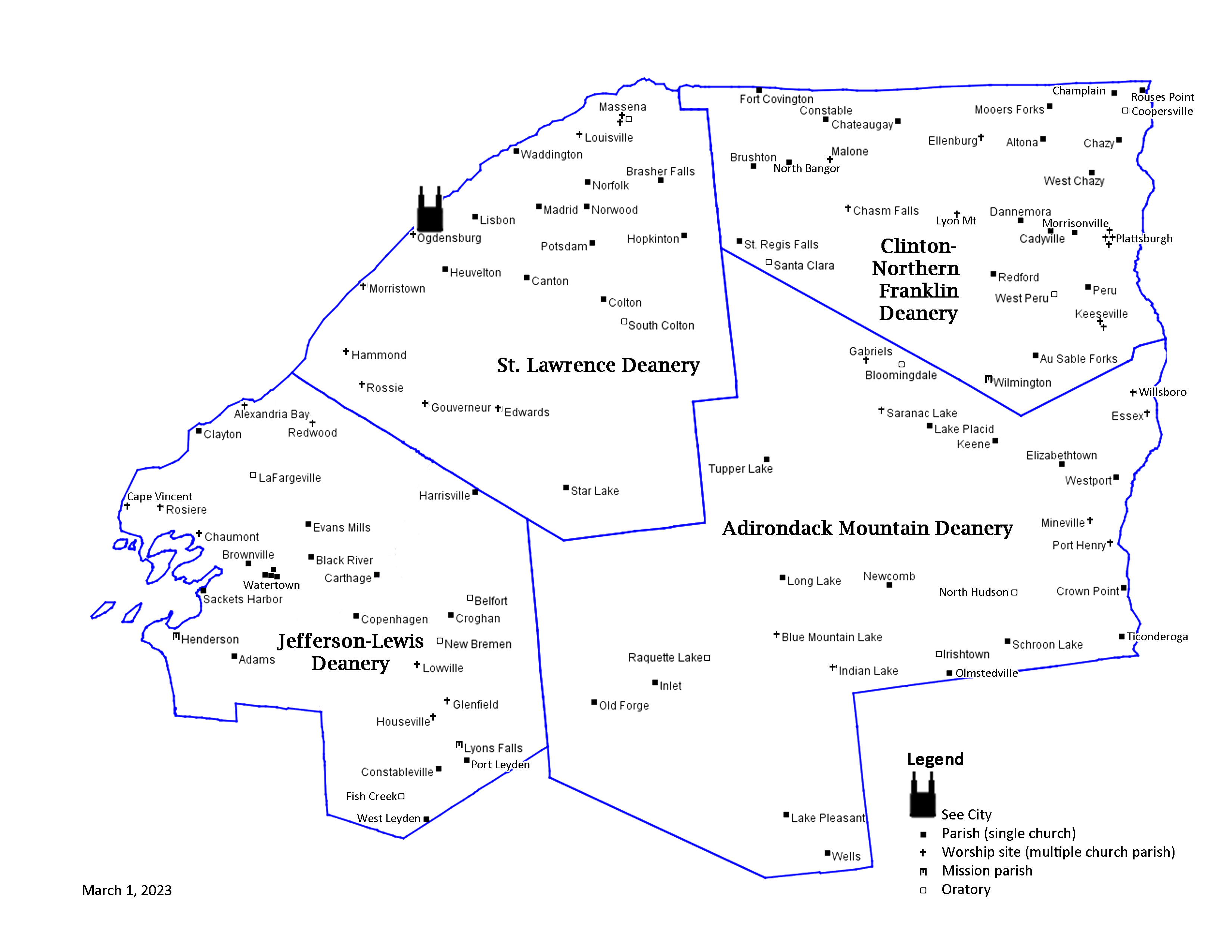Pastoral
Planning is an on-going process. The
current pastoral plan for the Diocese of Ogdensburg runs through 2025. The Living Stones Planning Committee (“LSPC”) has been focused the past several years on developing a pastoral plan
for 2025-2030. Under the leadership of
Mr. Gary West, the LSPC has developed a process to guide parish leaders as they
formulate a plan that will meet the needs of their parishioners moving forward.
The goal of pastoral planning is to
allocate our personnel and resources in a manner that will enable the Church to
serve the needs of our parishioners. A
vibrant parish is one that encourages its parishioners to be actively engaged
in the mission of the parish so the needs of all can be met. To be vibrant, a parish must (1) center its
life on prayer and liturgy, particularly the Sunday Eucharist, (2) offer faith
formation and evangelization that forms authentic and enthusiastic
parishioners; (3) receives sufficient support for its personnel and programs;
(4) demonstrates strong leadership by the pastoral staff, pastoral and finance
councils and trustees; (5) has sufficient staff to support its mission, and (6)
has adequate facilities to fulfil its mission.
The formulation of pastoral plans
for 2025-2030 will be particularly challenging.
During that timeframe fourteen of our current pastors will reach the
normal retirement age of 75. Additionally,
we currently have five pastors who are already over the age of 75 who will most
likely retire during that time period.
During this period, we anticipate there will be two to four ordinations
to the priesthood for our diocese.
These demographics present a challenge, but forming vibrant parishes to
carry on our mission as a diocese is possible.
In our diocese we are blessed by
permanent deacons, commissioned lay ministers, dedicated staff, and hard
working priests to lead our pastoral care areas. Increasing the commissioned lay leadership in
our pastoral care areas will be crucial in our 2025-2030 plan. Enabling permanent deacons to engage more
deeply in pastoral ministry in our parishes will ease the load for our priests
and will assure that we meet the spiritual needs of all.
In addition to the decline in the
number of pastors, our parishes have faced decreased income and lower Sunday
Mass. This follows national trends, but
the challenge is greater in our region of the country where we see an overall
loss of population, an aging population, a challenging economy, and pervasive
secularization.
“Cooperation between parishes that
make up our pastoral care areas will be more an more important as we move
forward,” according to Gary West, Chair of the LSPC. The process for formulating pastoral plans
encourages pastoral care areas to reflect on how to provide sustaining worship,
especially Sunday Mass in which all are fully and actively participating. Pastoral care areas are also asked to assure
sufficient stewardship to supports its mission, provide effective lay
leadership, provide for an adequate staff, enable it to accomplish its mission
and maintain its facilities. “Making the
pastoral care areas vibrant is our focus and our goal,” said Mr. West.
The process charted by the LSPC
proposes twenty-nine pastoral care areas for our diocese. The plan asks the pastoral care areas to
focus on becoming more vibrant and gives 39 guidelines and policies to help
them in their task.
”I am grateful to the Living
Stones Planning Committee,” said Bishop Terry R. LaValley. “The planning process presents us with some
challenges, but I am confident that we can work together in forming vibrant
parishes that well serve the people of the North Country. Trusting in the Holy Spirit and cooperating
with God’s grace, we can continue our mission of proclaiming the Gospel and
serving our brothers and sisters. I ask
that we all embrace this planning process and that we be willing to make the
hard choices and accept the sacrifices that will be necessary to make this
process successful”.
In the coming months, the deans of
the diocese will convene the clergy in their deanery to explain the challenges,
the process for planning, and guide the process as it moves forward. The clergy, in turn, will lead the process on
the parish level by bringing clergy, religious and lay people together to
evaluate their needs and formulate their plan for parish vibrancy. When the pastoral care areas have finished
their work, the Living Stones Planning Committee will recommend specific pastoral
plans to Bishop LaValley. Pastoral
plans will be implemented as circumstances dictate over the course of the next
five years.
“This is an important undertaking,”
said Bishop LaValley, “and the sacrifices we make now will pay dividends in the
future of our diocese. Please pray for
and participate in this important planning process.”
The Diocese
of Ogdensburg, covering an area of 12,036 square miles, was
established by Pope Pius IX on February 16, 1872.
The diocese is comprised of 77 parishes and 3 mission parishes made up of 101 worship sites, 12 parochial oratories, 2 high schools, 6 elementary schools and 1 nursing home. Catholics are served by 46 active diocesan priests, 10 priests belonging to religious institutions, and 4 priests belonging to other dioceses. Currently, 3 active priests are outside the United States: 2 studying Canon Law and 1 for immigration purposes. At Fort Drum, 2 priests serve as chaplains of the Archdiocese for Military Services. We have 29 retired and disabled diocesan priests, many continue to minister in various roles. We are blessed with 87 permanent deacons, 55 religious sisters and 594 commissioned lay ministers.
The Catholic population in the Diocese is 71,315, which is 16.8%
of the total population.
For more information on our parishes, please check out online Diocesan Directory.

